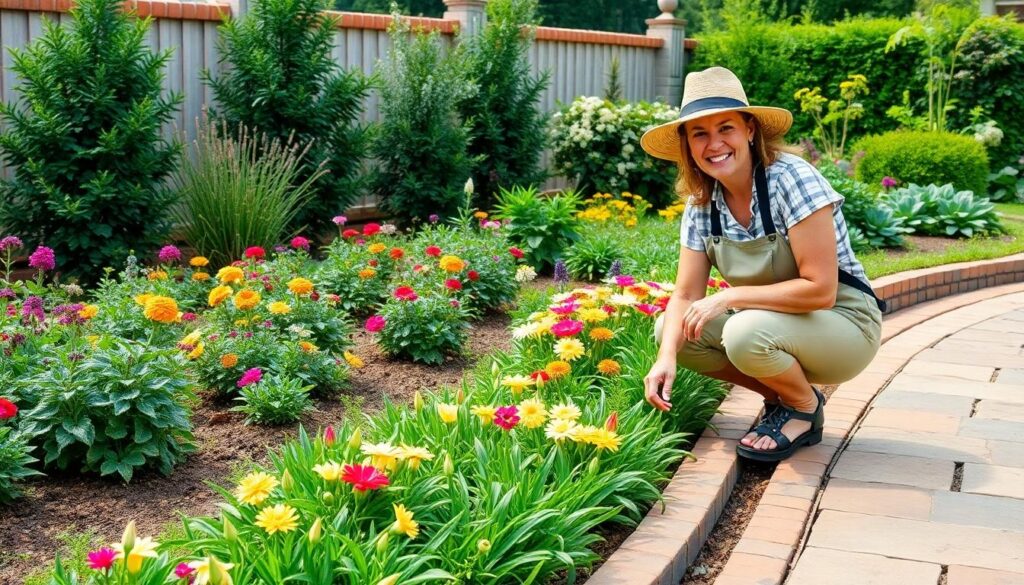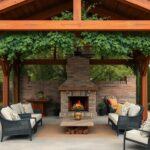Transforming your garden from ordinary to extraordinary starts with the details, and garden edging is the perfect place to begin. Those clean, defined lines between your lawn, flower beds, and pathways don’t just happen by accident—they’re the result of thoughtful edging choices that bring structure and polish to your outdoor space.
We’ve gathered the most inspiring garden edging ideas that combine both beauty and functionality. Whether you’re working with a modest budget or ready to invest in premium materials, there’s something here for every gardener. From classic brick borders to modern metal designs, the right edging solution can dramatically enhance your industry while making maintenance significantly easier.
10 Creative Garden Edging Ideas to Transform Your Outdoor Space
1. Classic Brick Edging
Brick edging offers timeless appeal that complements virtually any garden style. We love how versatile brick can be—laid flat, positioned at an angle, or stacked for a raised border effect. Reclaimed bricks add character with their weathered appearance and varied colors. For installation, simply dig a shallow trench, add a layer of sand for leveling, and place your bricks in your desired pattern. This durable option creates clean lines between lawn and garden beds while withstanding harsh weather conditions year after year.
2. Natural Stone Borders
Natural stone borders bring organic elegance to garden spaces with their irregular shapes and earthy tones. Garden designers often choose limestone, slate, or flagstone for their distinctive textures and colors. These stones can be partially buried for a rustic look or meticulously arranged for a more polished appearance. Many homeowners appreciate how stones collected from local areas can reduce costs while creating a border that perfectly blends with the surrounding industry.
3. Wooden Log Edging
Log edging creates a charming, rustic boundary using cut timber sections. Short logs placed vertically in the ground offer a natural aesthetic that works beautifully in cottage and woodland gardens. Cedar and locust woods are excellent choices thanks to their natural resistance to rot and insects. For installation, logs should be sunk at least one-third of their length into the soil to ensure stability while maintaining their rustic appeal among your plantings.
4. Concrete Curb Edging
Concrete curbing provides a seamless, professional-looking border that can be customized to any shape. Special equipment extrudes continuous concrete edges that conform perfectly to your garden’s contours. Color additives and stamping techniques can mimic the appearance of stone or brick at a lower cost. Professional installation ensures lasting results that resist cracking and shifting, creating permanent definition between lawn areas and planting beds.
5. Recycled Glass Bottle Borders
Glass bottle borders inject vibrant color and whimsy into garden spaces while promoting sustainability. Bottles can be buried neck-down in a trench to create a scalloped edge that catches sunlight beautifully. Wine bottles, beer bottles, and colored glass containers in various hues create striking visual effects when sunlight filters through them. This budget-friendly option transforms everyday waste into garden art that sparks conversation among visitors.
6. Metal Edging Options
Metal edging delivers sleek, contemporary lines that complement modern industry designs. Corten steel develops a protective rust patina that looks stunning against green foliage. Aluminum and galvanized steel options remain maintenance-free for years while maintaining clean boundaries. The thin profile of metal edging creates near-invisible borders that allow plants to take center stage while effectively containing mulch and preventing grass encroachment.
7. Woven Willow Edging
Woven willow creates living fences with a distinctive, handcrafted appearance. Flexible willow stems can be bent and woven between upright stakes to form attractive barriers around beds. This biodegradable option adds texture and natural charm to cottage gardens and wildlife-friendly spaces. As the willow ages, it develops a silvery patina that enhances its rustic appeal before eventually returning to the soil, making it an environmentally conscious choice.
8. Upcycled Material Borders
Repurposed materials transform ordinary boundaries into conversation pieces while reducing waste. Old roof tiles arranged in a row create scalloped edges with vintage character. Broken concrete pieces from demolished sidewalks become “urbanite” borders with industrial charm. Wine corks collected in wire cages form flexible barriers with unique texture. These creative approaches combine sustainability with personality, reflecting the gardener’s resourcefulness and environmental values.
9. Living Plant Borders
Living borders use low-growing plants to create natural boundaries between garden areas. Boxwood, lavender, and germander can be trimmed into neat hedges that define spaces with greenery. Creeping thyme, sedum, and sweet alyssum spill over edges to soften hardscape transitions with their flowers and foliage. These plant borders serve double duty by attracting pollinators while creating visual definition throughout your garden industry.
10. Gabion Stone Cage Edging
Gabion edging uses wire cages filled with stones to create distinctive borders with industrial-modern appeal. These structures can be built to any height or length, serving as both edging and retaining walls where needed. Various filling materials like river rocks, recycled glass, or broken concrete create different visual effects. The permeable nature of gabions allows excellent drainage while providing stable borders that resist erosion and shifting in sloped garden areas.
Using Natural Stone for Elegant Garden Borders
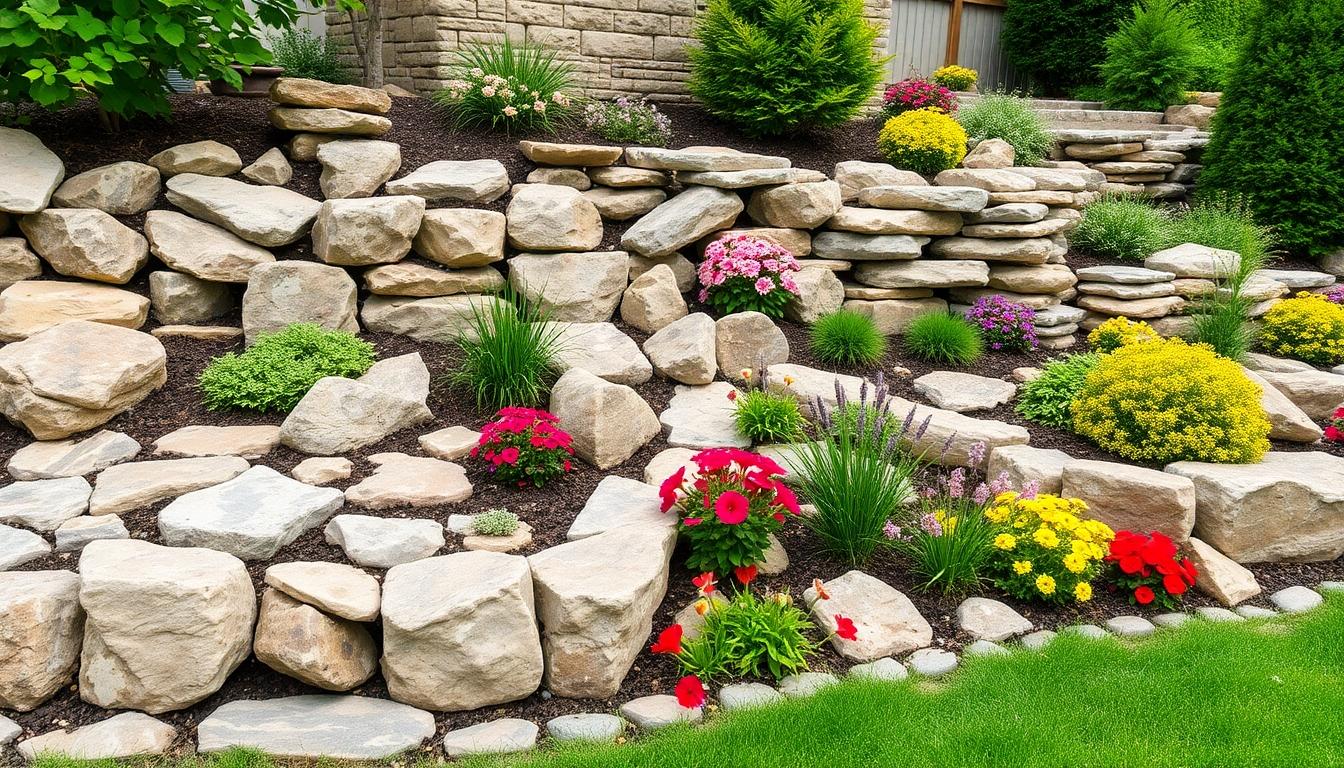
Natural stone edging creates timeless, organic boundaries for your garden spaces while improving visual appeal. These elegant borders not only contain mulch and gravel but also significantly reduce maintenance by creating clear separation between lawns and planting beds.
River Rock Arrangements for a Rustic Look
River rocks deliver a soft, rustic aesthetic that’s perfect for informal garden borders. Their naturally rounded edges create a smooth, flowing appearance that blends seamlessly into landscapes. These versatile stones effectively minimize soil erosion while adding textural interest to your garden spaces. Combining river rocks with fine gravel adds layered dimension and improves drainage capabilities throughout your planting areas. Techo-Bloc’s Rocka edging designs showcase how effectively river rock arrangements can transform ordinary garden boundaries into striking industry features. Weather resistance makes river rock an excellent long-term investment for gardens in various climate conditions.
Stacked Stone Walls for Raised Garden Beds
Stacked stone walls provide excellent structure for raised garden beds while adding vertical interest to your industry design. Flat stones like flagstone or sandstone work best for this application, allowing precise stacking for tiered garden designs. This method significantly enhances drainage and introduces a rugged, natural charm to garden spaces. Creating stable stacked walls requires establishing a level base foundation to prevent shifting over time. Smaller stones or gravel can be used as filler between larger pieces to ensure wall stability throughout seasons. Weather-resistant stone types like granite or basalt offer maximum durability for these structures. Gardens gain both functional benefits and visual appeal with these natural boundaries that complement plantings of all types.
Repurposing Everyday Items as Unique Garden Edging
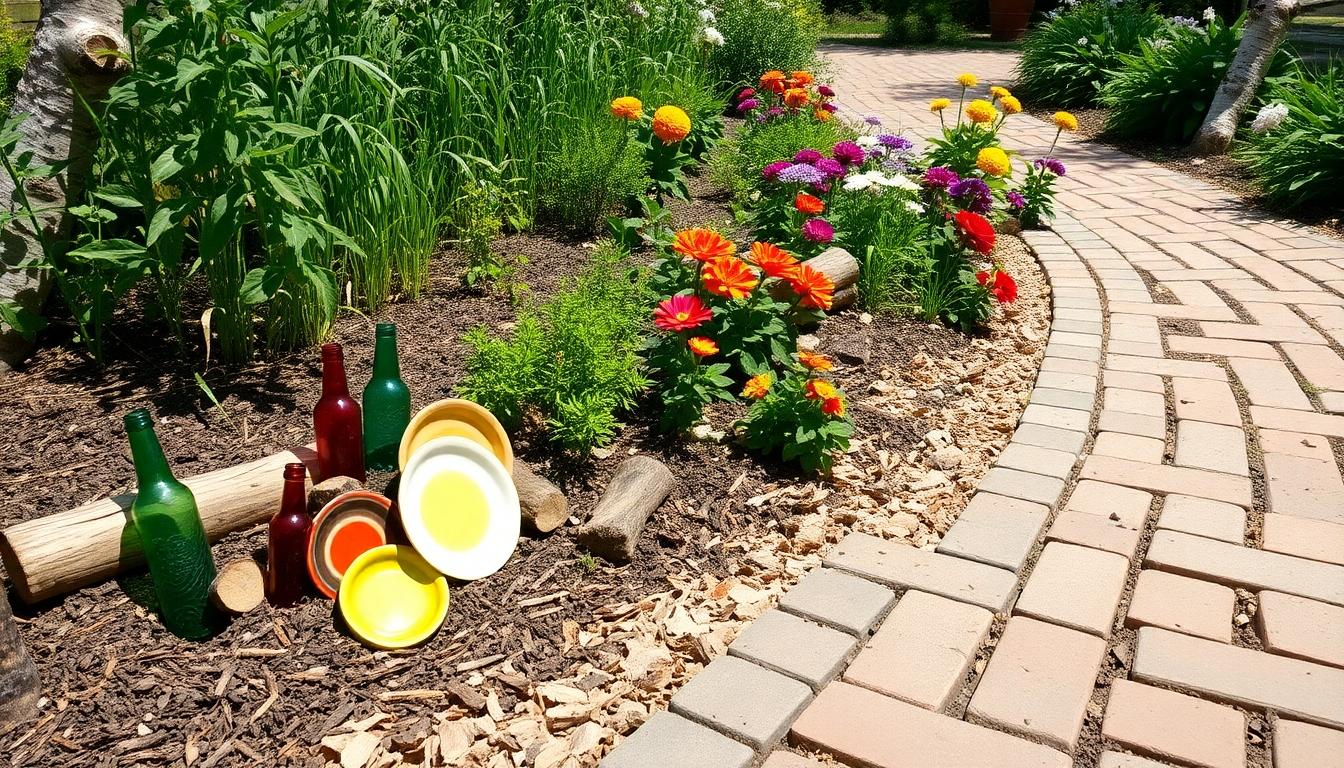
Creating distinctive garden borders doesn’t require expensive materials or professional installation. Everyday items can be transformed into eye-catching garden edging answers that add personality while being budget-friendly.
Plates and Bottles for Colorful Borders
Old plates and glass bottles make excellent recycled garden edging materials that bring vibrant colors to your outdoor space. These items create an eclectic border that stands out from traditional edging options. Collecting mismatched vintage plates from thrift stores allows you to design a truly personalized edge that reflects your unique style. Partially burying these items creates a whimsical border that’s both decorative and functional. This approach is particularly popular in recycled garden designs where sustainability meets creativity.
Birch Logs for Natural Woodland Appeal
Birch logs cut into equal lengths offer a rustic, natural border that complements woodland-inspired gardens. Simply bury these uniform log sections partially in the soil to create a clean, organic boundary between different garden areas. Their distinctive white bark provides excellent visual contrast against green foliage and colorful flowers. This edging solution works exceptionally well in settings with abundant natural materials and adds a touch of forest charm to urban gardens.
Wood Chip Mulch for Practical Borders
Wood chip mulch serves as both a practical and aesthetically pleasing garden edging solution. This inexpensive option not only defines garden borders clearly but also offers functional benefits by retaining soil moisture and suppressing weed growth. Creating a thick band of wood chips between lawn and garden beds provides a natural-looking transition that’s easy to maintain. The organic appearance of wood chips blends seamlessly with most garden styles while offering flexibility in shape and design.
Vintage Brick Pathways with Character
Brick edging offers versatility and affordability while adding classic charm to garden borders. Creating curved brick borders allows for a more relaxed installation process that doesn’t require perfect alignment. These gentle curves add visual interest and soften the overall look of your garden design. For more dramatic effect, try laying bricks diagonally on top of each other to create unique patterns that stand out in traditional garden settings. The weathered appearance of vintage bricks brings character and established elegance to newly designed gardens.
Glass Bottle Borders for Eclectic Charm
Glass bottles pushed neck-first into the soil create a truly distinctive garden edge that catches sunlight in magical ways. Dig a shallow trench along your garden edge and arrange bottles of various colors for a rainbow effect that transforms throughout the day as light filters through the glass. This whimsical approach works particularly well for herb gardens or children’s garden spaces. The bottles not only serve as functional borders but also act as light catchers, creating beautiful patterns when sunlight shines through them. This recycled edging solution combines sustainability with artistic expression in your outdoor space.
Budget-Friendly Garden Edging Solutions
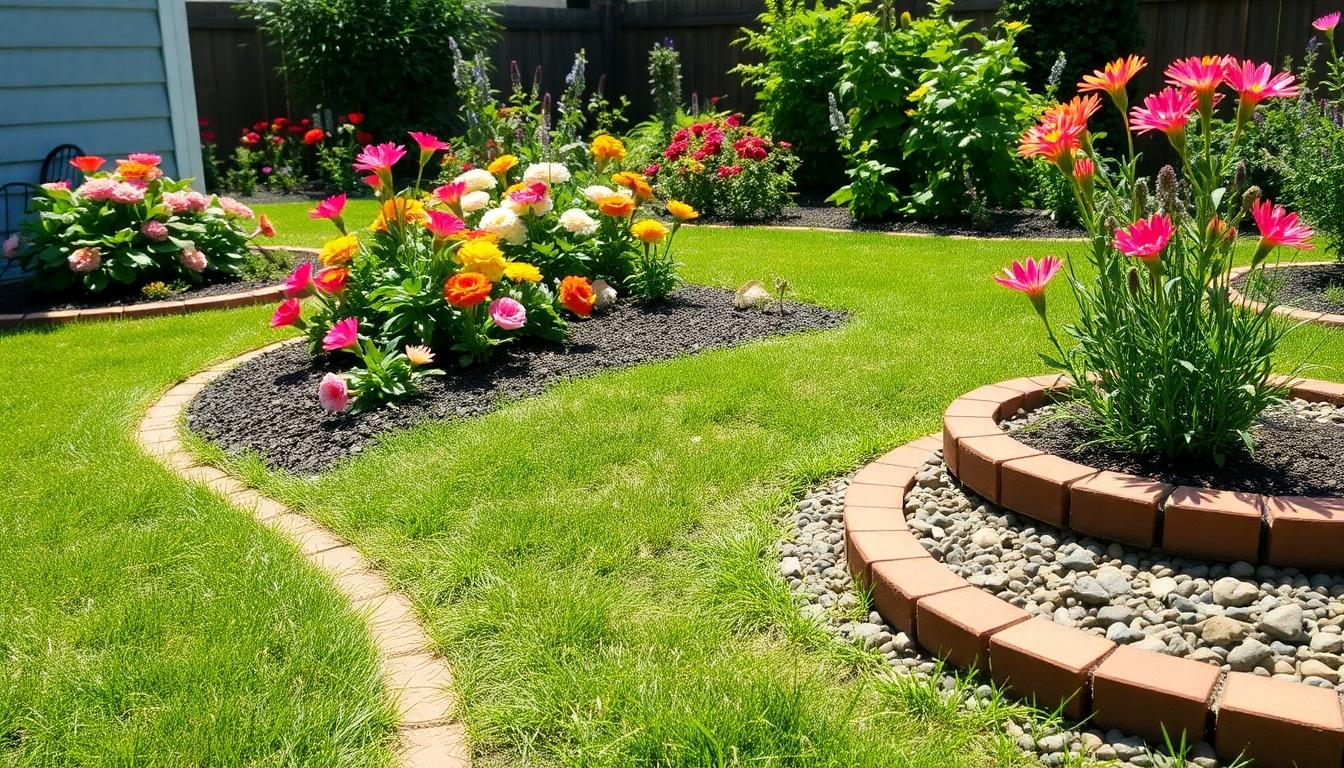
Creating beautiful garden borders doesn’t have to expensive. Here are several cost-effective options that add structure and style to your outdoor space.
Mulch Borders
Mulch borders offer one of the simplest and most affordable edging answers available. Wood chip mulch effectively separates lawns from garden beds while simultaneously reducing weed growth and retaining valuable soil moisture. Simply create a defined edge between your lawn and garden, then fill the border area with a 2-3 inch layer of mulch for an instant, natural-looking boundary that requires minimal maintenance.
Brick Edging
Brick edging provides exceptional durability at a reasonable cost, making it perfect for DIY garden projects. You can arrange bricks in curved or straight patterns depending on your garden design preferences. Installation requires basic tools and minimal expertise—simply dig a shallow trench, add sand for leveling, and place your bricks in your desired pattern. At $1-$5 per brick, this option delivers professional-looking results without the professional price tag.
Gravel Trenches
Gravel trenches create clean, permeable garden edges that enhance drainage. To create this border, dig a 4-inch-deep trench around your garden bed, line it with weed barrier fabric, and fill with decorative gravel or small stones. This method costs approximately $0.50-$2 per square foot and offers excellent longevity with minimal upkeep requirements.
Recycled Rubber Borders
No-dig rubber edging offers an eco-friendly solution that withstands regular contact with lawn mowers. These flexible borders install quickly with included pegs, creating a clean division between garden spaces. Recycled rubber provides excellent durability in all weather conditions while requiring virtually no maintenance once properly installed.
Pebble or Stone Borders
Natural stone arrangements create visually appealing garden edges at minimal expense. Collect rocks of similar sizes to arrange along garden boundaries or purchase landscaping stones to create more uniform borders. This option requires few tools and little expertise, making it ideal for gardeners on a tight budget who still want impressive results.
DIY Concrete Garden Edging Projects
Poured concrete edging offers endless customization possibilities for garden borders. Create curved or geometric shapes using flexible molds, then pour your concrete mixture for a professional-looking edge. Remember to allow proper curing time (24-48 hours) before walking or working near your newly installed concrete edges. This method delivers permanent results at a fraction of professional installation costs.
Concrete pavers provide another versatile option for garden borders. Reuse broken concrete pieces or cast your own DIY pavers using simple forms for a polished look. These pavers can be set flush with the ground or slightly raised depending on your garden needs, offering excellent durability for high-traffic areas.
Concrete block borders add vertical interest to garden spaces. Stack small concrete blocks or cut larger blocks in half and install them vertically into the soil to create a defined raised edge. This technique works particularly well for separating garden beds from lawn areas or creating terraced planting spaces on sloped properties.
Reclaimed Wood Border Ideas
Vertical plank borders create rustic charm using salvaged wood materials. Install reclaimed wooden planks vertically along garden edges, securing them with stakes or by burying the bottom portion below soil level. This technique adds height and visual interest while recycling materials that might otherwise go to waste.
Railroad tie borders offer substantial, long-lasting edges for raised garden beds. When using reclaimed railroad ties, verify they’re safe for edible gardens, as some older ties contain harmful preservatives. Position these heavy-duty borders to create defined planting areas that resist soil erosion and add rustic appeal to your industry design.
Log borders transform fallen trees or purchased logs into naturalistic garden edges. Split untreated logs horizontally and stake them into the ground along garden perimeters for an organic, woodland-inspired border. This approach offers an excellent way to repurpose storm damage or tree removal materials into functional garden features.
Pallet wood edging allows you to create horizontal or geometric borders using disassembled wooden pallets. Secure these reclaimed wood pieces with galvanized nails to prevent rusting and ensure longevity. This technique combines sustainability with affordability, giving your garden a distinctive character without important expense.
Metal Garden Edging for Modern Landscapes
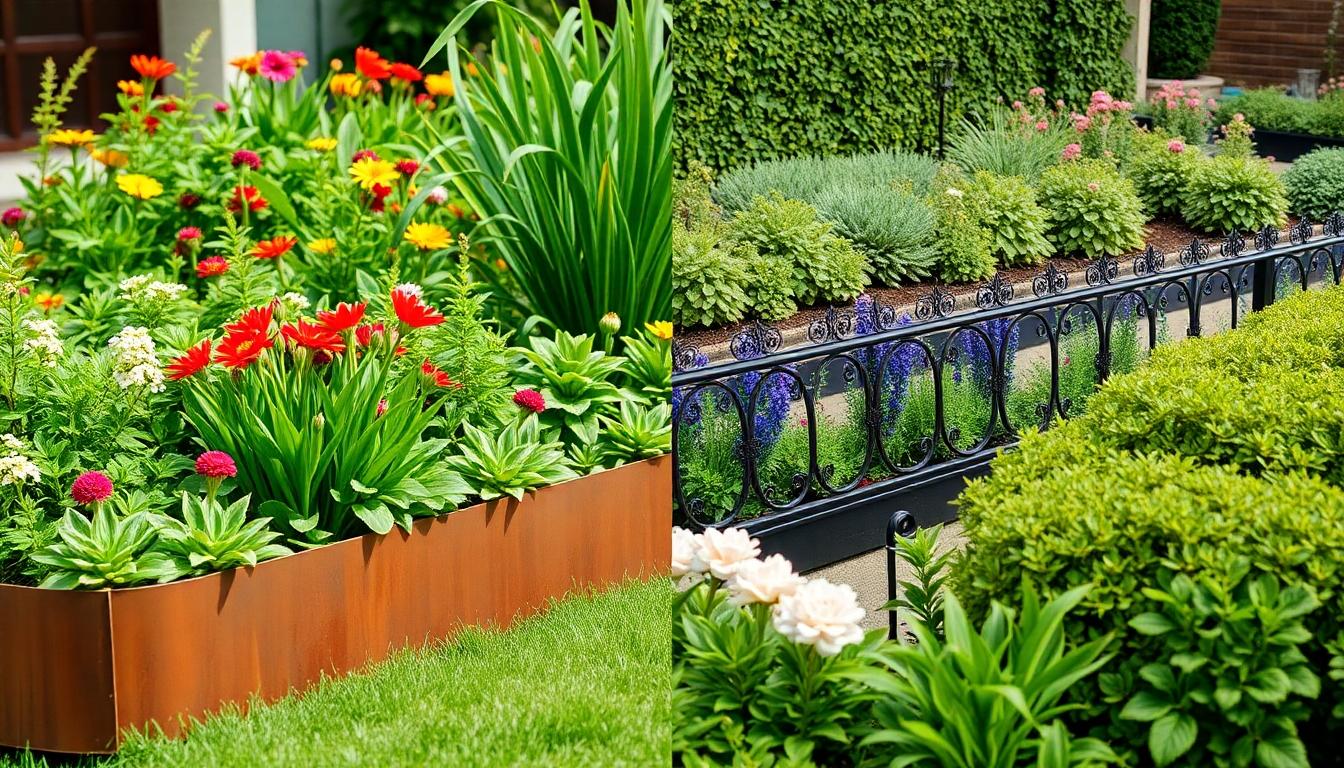
Metal garden edging offers a sleek, contemporary solution for modern industry designs. These durable borders create crisp, clean lines that instantly elevate your outdoor space while providing excellent longevity compared to other materials.
Corten Steel Edging for a Contemporary Feel
Corten steel edging has become increasingly popular in contemporary garden designs for its distinctive weathered appearance. This remarkable material intentionally develops a protective rust-colored oxide layer over time, creating a striking contrast against greenery while ensuring exceptional durability. Gardens featuring corten steel borders benefit from their low maintenance requirements, as the oxidation process actually protects the metal from further deterioration. The warm, earthy tones of corten steel complement modern architectural elements and create a sophisticated transition between different garden zones. Many industry designers appreciate how this material can be easily shaped into both straight lines and gentle curves, making it versatile for various design applications.
Decorative Iron Borders for Classic Gardens
Decorative iron edging brings timeless elegance to traditional garden layouts with its ornate patterns and sophisticated appearance. These borders provide both functional separation and visual enhancement, standing as artistic elements within your garden design. Iron edging’s impressive durability withstands seasonal changes and maintains its integrity for years, making it a worthwhile investment for discerning homeowners. Gardens with formal layouts particularly benefit from decorative iron borders that reinforce symmetrical designs and highlight manicured plantings. The malleability of iron allows for intricate detailing and custom shapes to match exact aesthetic preferences, from Victorian-inspired scrollwork to more restrained geometric patterns. Professional installation ensures these borders remain securely anchored, creating clean divisions between lawn areas and planted beds.
Living Garden Edges with Plants and Flowers
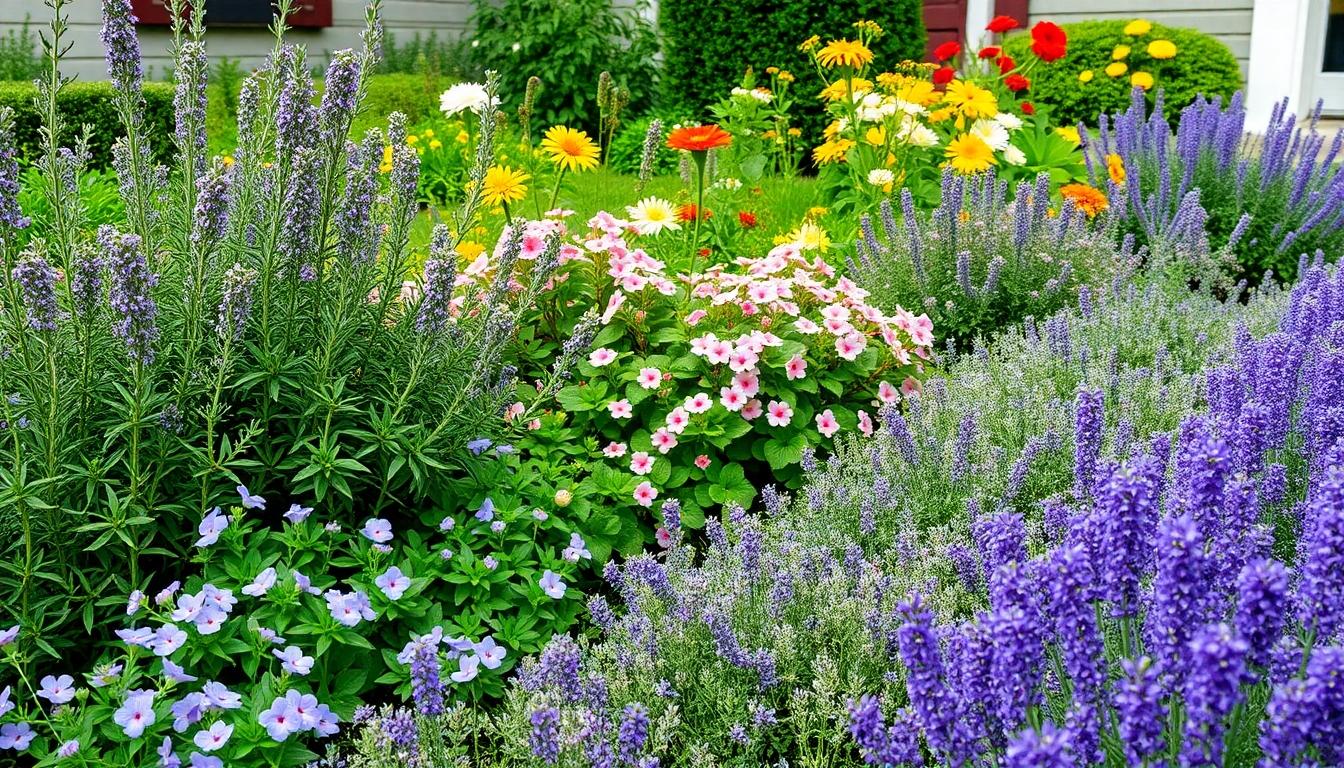
Living garden edges create natural, beautiful boundaries using plants and flowers rather than hard materials. These botanical borders add texture, color, and life to garden spaces while defining different areas effectively.
Herb Borders That Combine Beauty and Function
Herb borders offer a perfect blend of aesthetic appeal and practicality for garden edging. Rosemary creates aromatic, evergreen boundaries that thrive in full sun conditions and require minimal maintenance. Thyme forms a lovely ground cover that releases its fragrance when brushed against or walked upon. Mint provides lush green borders but should be contained as it spreads aggressively throughout the garden. These versatile herbs can be strategically planted along garden paths or surrounding flower beds to create borders that aren’t just visually appealing but also supply fresh ingredients for cooking. The dual functionality of herb borders makes them an excellent choice for gardeners looking to maximize both beauty and utility in their outdoor spaces.
Low-Growing Perennials as Natural Edging
Low-growing perennials excel as natural garden edging options that require minimal maintenance while providing visual definition. Creeping Phlox spreads rapidly across the ground, creating carpets of vibrant pink, purple, or white flowers in spring that clearly mark garden boundaries. Moss Rose thrives in full sun conditions and quickly establishes itself to form colorful, drought-resistant borders that bloom throughout summer. Creeping Juniper offers a compact form that’s perfect for sunny locations, providing year-round structure and interest with its evergreen foliage. Lavender brings both visual appeal and wonderful fragrance to garden edges, forming compact hedges that thrive in full sun and attract beneficial pollinators. Hostas work beautifully as edging plants in shady areas, offering varied foliage colors and textures that create distinctive garden borders. Begonias provide colorful edging answers for partially shaded gardens with their pink, red, white, yellow, or orange blooms. Daylilies make excellent border plants for sunny locations, combining attractive foliage with vibrant flowers that bloom reliably in spring and summer.
Plastic and Composite Edging for Low-Maintenance Gardens

Plastic and composite materials offer exceptional durability and flexibility for garden borders while minimizing upkeep requirements. These modern edging answers provide clean lines and lasting performance even in challenging conditions.
Plastic Edging: Available in flexible rolls or decorative styles that adapt perfectly to curved garden designs. Most plastic edging requires almost no maintenance and comes with stakes for secure installation. The material resists rot, moisture damage, and weathering, making it ideal for busy gardeners looking for long-term answers without the hassle of regular upkeep.
Composite Edging: Crafted from recycled wood-plastic blends that convincingly mimic natural woodgrain textures. These innovative materials combine the best qualities of wood aesthetics with enhanced resistance to insects and decay. Composite options deliver durability comparable to plastic edging but with significantly improved visual appeal for gardens where appearance matters.
No-Dig Garden Edging Installation Tips
- Select the right soil conditions for installation, working with soft ground that’s neither waterlogged nor frozen. Creating optimal conditions ensures your edging stays in place through seasonal changes.
- Prepare a shallow trench along your bed perimeter using a spade, making just enough space for the edging material to sit properly. The trench provides stability and creates a clean installation line.
- Position your edging carefully into the prepared groove, ensuring it sits completely flush with the ground surface. Proper placement prevents tripping hazards and creates a seamless transition between different garden areas.
- Secure plastic or metal edging with the included stakes at regular intervals for maximum stability. Proper anchoring prevents shifting during weather events or garden activities.
- Consider natural alternatives like logs or branches that can be placed directly on trimmed lawn edges without any digging. These options provide an instant, eco-friendly solution with minimal ground disturbance.
Weather-Resistant Options for Extreme Climates
Metal Edging Answers: Aluminum and steel versions stand up remarkably well to high winds, heavy rainfall, and dramatic temperature fluctuations. These materials maintain their shape and function regardless of weather conditions, making them perfect for regions with unpredictable or harsh climates. Metal options can be easily bent to accommodate curved garden layouts without warping or losing structural integrity over time.
Cedar and Redwood Borders: Naturally equipped with oils that resist rot and repel destructive insects, making them excellent choices for humid or consistently wet environments. These woods maintain their appearance and function far longer than standard lumber options without requiring chemical treatments.
Stainless Steel Edging: Delivers a sleek, low-profile finish that complements modern industry designs while withstanding extreme weather conditions. The material combines aesthetic appeal with exceptional durability, creating clean lines that define garden spaces with minimal visual intrusion.
Cost Considerations: Budget-friendly plastic edging typically runs under $1 per linear foot, though prices vary based on style and quality. Composite materials represent a mid-range investment that balances durability with aesthetic appeal. Metal options generally require a higher initial investment but deliver exceptional longevity, significantly reducing replacement needs and providing better long-term value even though the upfront cost.
Concrete and Paver Garden Edging Designs
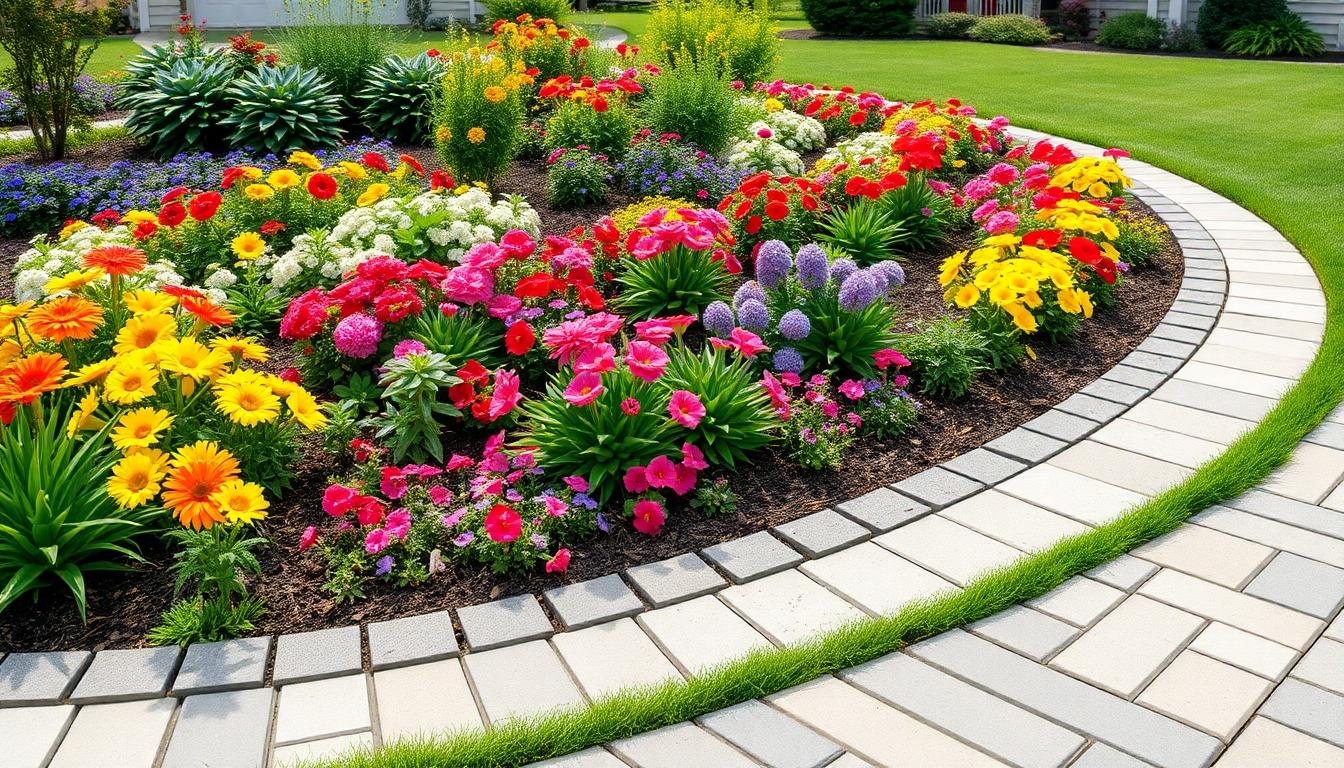
Concrete and paver garden edging offers exceptional durability while providing sophisticated dividing lines between lawn and flower beds. These versatile materials create defined spaces that enhance your garden’s overall aesthetic appeal with minimal maintenance requirements.
Stamped Concrete Patterns for Custom Looks
Stamped concrete edging brings remarkable versatility to garden designs through its ability to replicate various textures such as stone or brick. This material offers a truly custom look that seamlessly complements any garden theme by providing cohesive finishes with patterns that match your surroundings. Colors can be mixed into the concrete during installation to coordinate with existing industry elements, creating a unified appearance throughout your outdoor space. Concrete mold edging allows for creating distinctive borders with unique shapes and patterns that stand up to harsh weather conditions year after year. Many homeowners appreciate that stamped concrete requires virtually no maintenance while retaining its appearance for decades.
Interlocking Pavers for Clean Garden Lines
Interlocking pavers excel at creating clean, sharp garden lines that define distinct areas within your industry. Available in many colors, shapes, and sizes, these versatile edging materials adapt to fit virtually any garden design style. Installation proves relatively straightforward, making interlocking pavers an accessible option for DIY enthusiasts looking to upgrade their garden borders. Their modular nature allows for easy repairs if individual pieces become damaged or stained over time. Pavers create a neat, organized appearance that enhances the visual appeal of flower beds, walkways, and lawn boundaries. Many industry designers recommend interlocking pavers specifically for their combination of aesthetic appeal and practical longevity in garden edging applications.
Eco-Friendly Garden Edging Alternatives
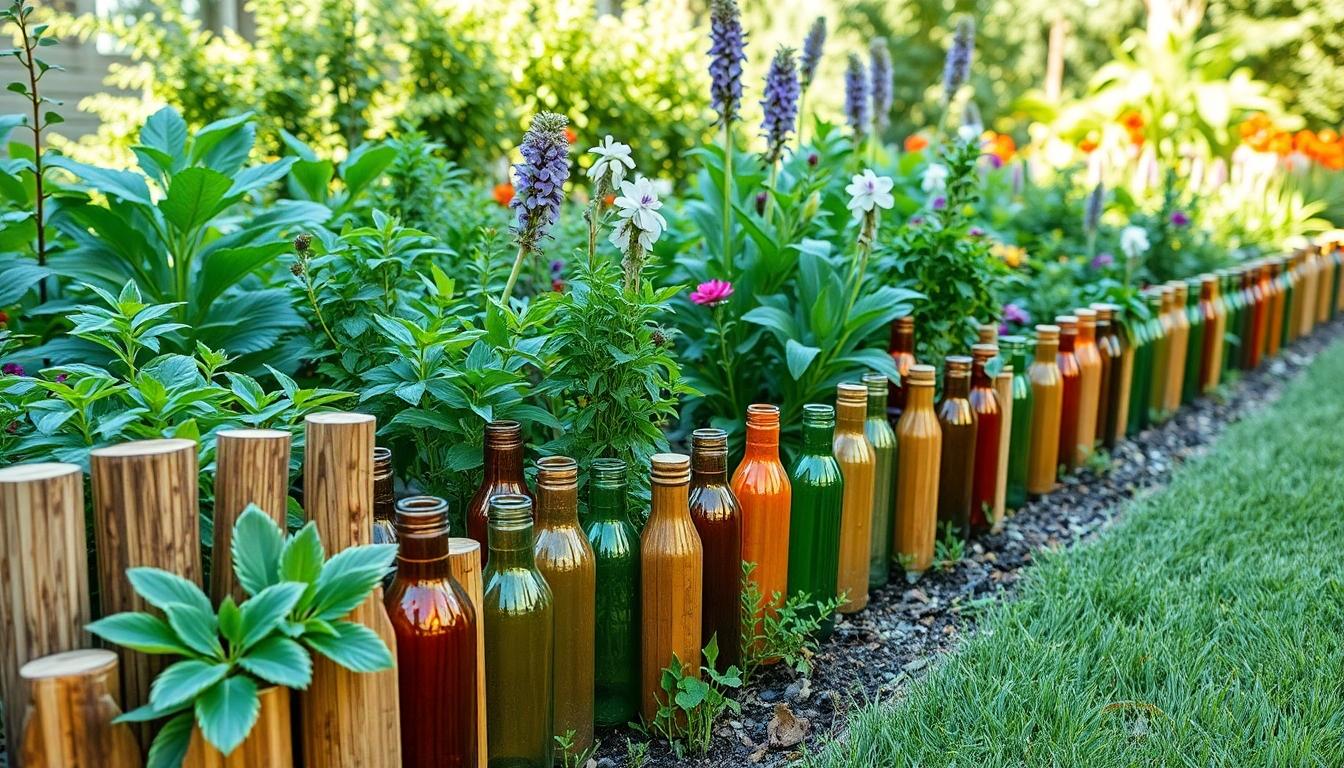
Sustainable garden edging options focus on using natural or recycled materials that minimize environmental impact while creating beautiful borders. These eco-friendly alternatives not only enhance your garden’s appearance but also support sustainable landscaping practices.
Bamboo and Sustainable Wood Options
Bamboo edging offers a renewable and completely biodegradable option for garden borders, making it perfect for curved beds and organic designs. Its natural resistance to decay ensures durability when properly sealed, providing long-lasting performance without harmful chemicals. Recycled wood planks create rustic, low-cost borders that naturally decompose over time, returning nutrients to your soil while defining garden spaces. Untreated hardwood or reclaimed timber can transform into structured raised beds or stacked borders, adding architectural interest while giving new life to materials that might otherwise go to waste. Fallen branches from your own property offer perhaps the most sustainable wood option, requiring zero transportation emissions and creating a woodland aesthetic that blends seamlessly with natural garden styles.
Recycled Material Edging Ideas
Recycled rubber edging, often manufactured from old tires, provides flexibility and durability without requiring any digging for installation. This material proves ideal for play areas or high-traffic garden zones where resilience matters most. Glass bottles buried neck-down create whimsical, colorful borders while diverting waste from landfills, allowing sunlight to filter through for a magical effect in your garden spaces. Reclaimed bricks or concrete chunks form weather-resistant, sturdy edges that add character and history to garden designs while keeping construction materials out of landfills. Plastic edging made from recycled polymers balances affordability with sustainability, though it typically degrades faster than rubber alternatives in outdoor conditions. Gravel edging using small stones creates permeable, low-impact borders that allow water to filter naturally into the soil, especially effective when paired with weed barriers for reduced maintenance. Living edges formed with native shrubs or groundcovers establish natural boundaries while supporting local ecosystems, providing habitat for beneficial insects and wildlife.
Seasonal Garden Edging Considerations
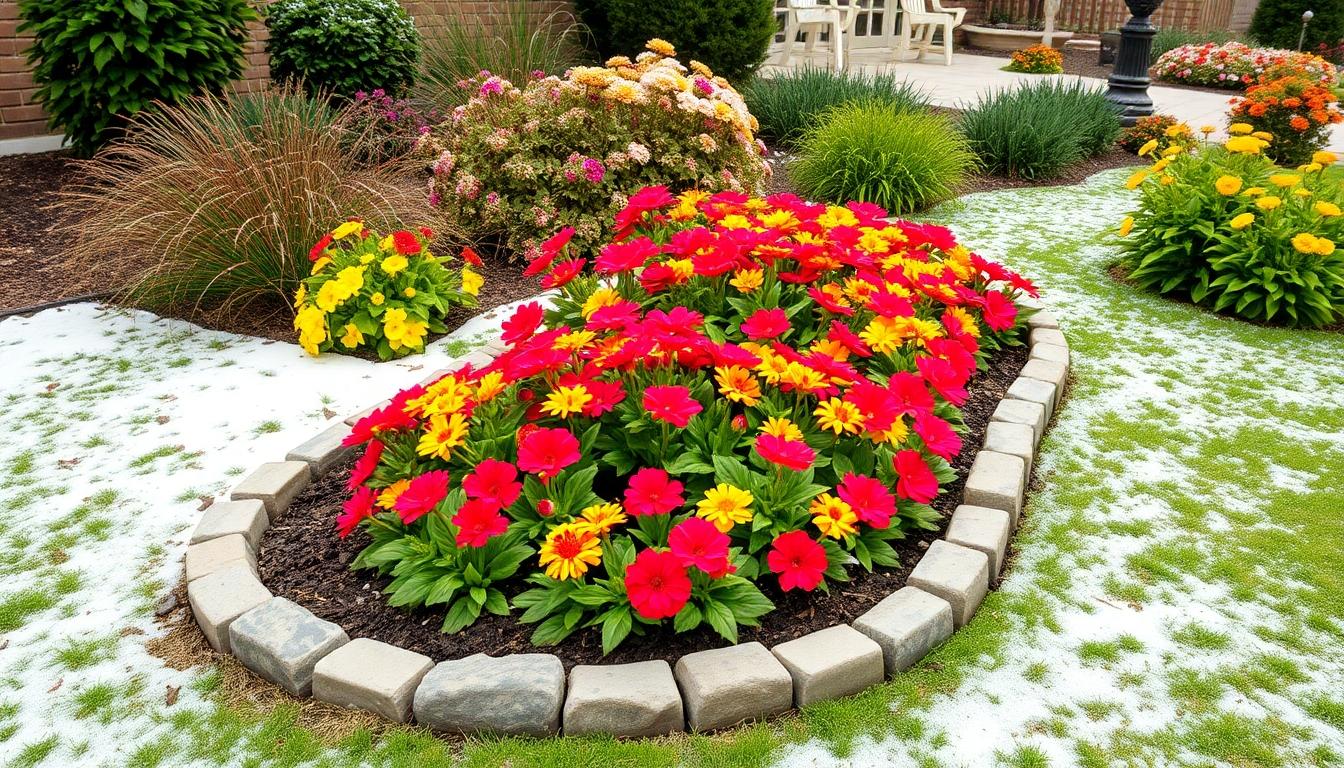
Your garden borders need different care and consideration throughout the year as seasons change. Selecting the right edging materials and designs for each season ensures your garden maintains its structure and beauty year-round.
Winter-Proof Edging Answers
Winter presents unique challenges for garden edging, particularly in regions with freeze/thaw cycles. Metal edging stands out as an exceptional choice for cold climates due to its resistance to shifting and cracking when temperatures fluctuate. Stone edging provides similar stability, maintaining its position even during harsh winter conditions and preventing soil erosion from melting snow. For areas with heavy snowfall, taller edging options create clear boundary markers that remain visible even under snow cover. We recommend avoiding plastic edging in extremely cold regions, as it tends to become brittle and may crack when temperatures drop significantly.
Adjustable Edging for Growing Gardens
Gardens evolve throughout the growing season, requiring edging that can adapt to changing conditions. Flexible materials like bender board offer the versatility needed to accommodate expanding plant growth without restricting root systems. Metal edging that can be bent into customized shapes works wonderfully for gardens with curved beds or changing designs. Installing edging with removable stakes creates an adaptive system that allows for quick adjustments as plants mature and spread. Sectional edging pieces provide another smart solution, letting you add or remove segments as your garden expands or contracts with seasonal growth. Many professional gardeners opt for these adjustable answers to ensure their garden borders can evolve with the natural growth cycles of their plants.
Choosing the Perfect Garden Edging for Your Landscape Style
Garden edging is truly the unsung hero of industry design. We’ve explored countless options from classic brick and stone to creative upcycled materials and eco-friendly alternatives. The perfect edging solution depends on your garden’s style budget and environmental considerations.
Remember that the right edging does more than just create boundaries—it enhances your garden’s structure reduces maintenance and showcases your personal style. Whether you prefer the contemporary look of metal the timeless appeal of natural stone or the sustainable charm of repurposed materials there’s an edging solution waiting to transform your outdoor space.
We encourage you to experiment with these ideas and watch how the right borders can elevate your garden from ordinary to extraordinary. Your perfect garden edge is waiting to be discovered!
Frequently Asked Questions
What is the purpose of garden edging?
Garden edging creates defined lines between different garden areas, adding structure and elegance to your outdoor space. It enhances your garden’s appearance, simplifies maintenance, and helps contain soil, mulch, and plants. Well-executed edging transforms an ordinary garden into an extraordinary one by providing visual organization and preventing materials from spilling onto pathways or lawns.
What are some classic garden edging materials?
Classic garden edging materials include brick, natural stone, and wood. Brick offers timeless appeal and durability. Natural stone provides organic elegance and weather resistance. Wood (especially logs) creates rustic charm. These traditional materials have stood the test of time because they complement various garden styles while effectively separating different garden zones.
How can I create garden edging on a budget?
Budget-friendly garden edging options include mulch borders for weed reduction, DIY brick installations, gravel trenches for drainage, recycled rubber borders, and natural stone arrangements. You can also repurpose everyday items like glass bottles, old plates, and wood chips. These affordable solutions provide both functionality and visual appeal without breaking the bank.
What are some eco-friendly garden edging options?
Eco-friendly garden edging includes bamboo (renewable and biodegradable), recycled wood planks, untreated hardwood, recycled rubber, glass bottle borders, and gravel edging. Living edges formed with native plants support local ecosystems. These sustainable options minimize environmental impact while enhancing garden beauty and promoting responsible landscaping practices.
How do I maintain garden edging in different seasons?
Seasonal garden edging maintenance varies throughout the year. In winter, focus on sturdy materials like metal and stone that withstand freezing temperatures. Choose taller edging for visibility under snow. In spring, repair any frost damage. During summer, prevent weed growth along borders. For fall, clear debris that could cause rot. Consider adjustable edging solutions that adapt to seasonal changes and plant growth.
What garden edging works best for modern landscapes?
Metal garden edging creates sleek, contemporary lines ideal for modern landscapes. Corten steel develops a distinctive weathered patina while remaining low-maintenance. Concrete curbing offers a professional, minimalist look with exceptional durability. For a more industrial-modern appeal, consider gabion stone cage edging. These options provide clean, crisp boundaries that complement contemporary garden designs.
Can everyday items be used for garden edging?
Yes, repurposed everyday items make unique, personality-filled garden edging. Old plates and glass bottles create colorful borders that catch sunlight beautifully. Birch logs offer natural woodland appeal. Vintage bricks add charm and versatility. Even wood chips can form practical borders. These creative solutions combine sustainability with distinctive character, making your garden uniquely yours.
What’s the most durable garden edging material?
Concrete and metal offer the greatest durability for garden edging. Concrete curbing and pavers create solid, permanent borders that withstand weather extremes and resist shifting. Stamped concrete provides versatility with custom patterns. Metal edging, particularly steel variants, offers exceptional longevity with minimal maintenance. These materials maintain their appearance and functionality for decades with proper installation.
How do I choose the right garden edging style?
Select garden edging that complements your home’s architecture and garden style. For traditional gardens, consider classic brick or decorative iron. Contemporary landscapes benefit from clean metal or concrete lines. Cottage gardens pair well with natural materials like stone or woven willow. Consider your climate, maintenance preferences, and budget. The right edging should enhance your garden’s beauty while serving practical purposes.
What garden edging requires the least maintenance?
Metal, stone, and concrete edging require minimal maintenance. Corten steel develops a protective patina that prevents further corrosion. Natural stone borders resist weathering and need occasional repositioning. Concrete edging remains stable for years with little attention. Recycled rubber edging is virtually maintenance-free. These durable options let you enjoy your garden’s beauty without constant upkeep.

